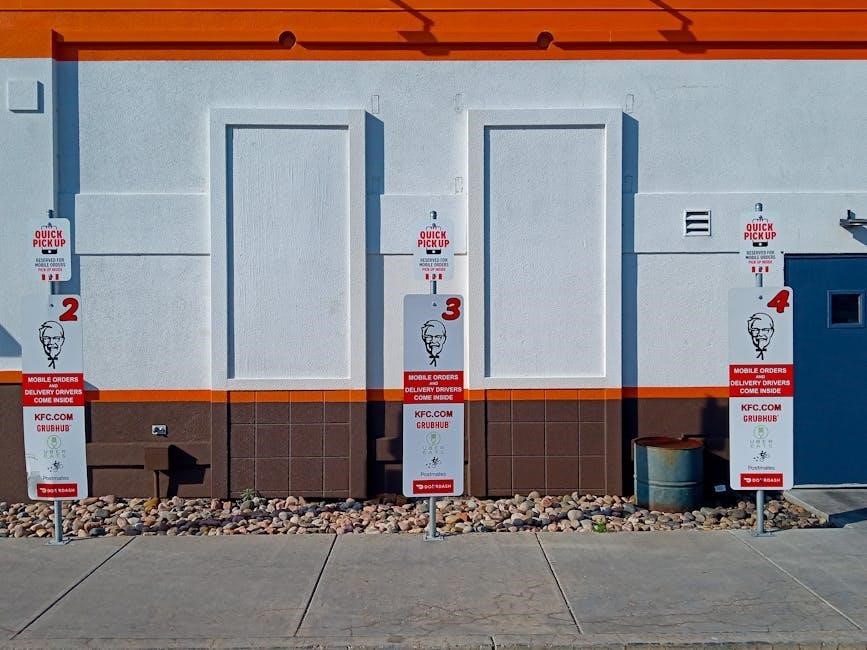This guide helps urban consumers navigate modern life by providing insights on budgeting, sustainability, and smart shopping, empowering them to make informed decisions in fast-paced environments.
1.1 Understanding the Urban Consumer
Urban consumers are tech-savvy, diverse, and constantly connected, seeking convenience, quality, and value. They prioritize sustainability and efficiency, often relying on digital tools for decision-making. Understanding their preferences, behaviors, and challenges is key to addressing their needs effectively in a fast-paced, high-cost environment. By recognizing their unique characteristics, urban consumers can be empowered to make informed choices that enhance their lifestyles and contribute to a more sustainable future.
1.2 Importance of Smart Consumption in Urban Areas
Smart consumption is crucial in urban areas due to high living costs and environmental pressures. It helps consumers make informed decisions, reducing waste and saving money. By prioritizing quality over quantity and using digital tools to find deals, urban consumers can enhance their lifestyles while contributing to sustainability. Smart consumption fosters resource efficiency, supports local economies, and promotes eco-friendly practices, all of which are essential for thriving in urban environments.

Budgeting and Financial Management
Budgeting is essential for urban consumers to manage high living costs and financial pressures. It helps track expenses, save money, and reduce debt, ensuring stability in urban life.
2.1 Creating a Budget for Urban Living
Creating a budget for urban living involves tracking expenses, categorizing spending, and setting financial goals. Start by identifying income sources and prioritizing essential costs like rent and utilities. Allocate funds for transportation, food, and entertainment, adjusting based on lifestyle. Use digital tools or spreadsheets to monitor spending and stay accountable. Regularly review and adjust the budget to reflect changes in income or expenses, ensuring financial stability in the high-cost urban environment. This structured approach helps manage debt and build savings effectively.
2.2 Managing Debt in a High-Cost Urban Environment
Managing debt in urban areas requires strategic planning and discipline. Prioritize high-interest debts and consider consolidation options to simplify payments. Use online tools to track expenses and identify areas for cost reduction. Negotiate with creditors for flexible payment plans and avoid unnecessary spending. Regularly review financial statements to stay informed and seek professional advice if overwhelmed. By addressing debt systematically, urban consumers can reduce financial strain and achieve long-term stability in costly city environments.
2.3 Saving Strategies for Urban Consumers
Urban consumers can adopt effective saving strategies by automating their savings, using budgeting apps, and exploring city-specific discounts. Prioritize needs over wants to reduce unnecessary expenses. Take advantage of tax-advantaged accounts and employer matching programs. Consider shared housing or splitting bills to lower costs. Avoid impulse purchases by implementing a 30-day waiting period for non-essential buys. Regularly review budgets to identify areas for optimization. By staying disciplined and leveraging available tools, urban consumers can build financial resilience despite high living costs.

Sustainable Living in Urban Areas
Sustainable living in urban areas involves reducing waste, conserving energy, and utilizing eco-friendly transportation. It promotes green spaces, lowers costs, and fosters environmentally conscious communities.
3.1 Reducing Waste in Urban Spaces
Reducing waste in urban areas requires mindful consumption and recycling practices. Consumers can minimize landfill contributions by selecting products with minimal packaging and participating in community recycling programs. Composting organic waste and avoiding single-use items also play a crucial role. Educating oneself on proper disposal methods and supporting brands that prioritize sustainability can further reduce urban waste, fostering cleaner, healthier environments for future generations.
3.2 Conserving Energy in the City
Conserving energy in urban areas is essential for sustainability. Start by using energy-efficient appliances and LED lighting. Smart home devices can automate energy usage, turning off lights and electronics when not in use; Adjust thermostat settings and unplug chargers to reduce standby power consumption. Opt for public transport, walk, or carpool to lower energy use from transportation. Use natural light during the day and invest in energy-saving window treatments. Encourage renewable energy sources and maintain appliances for optimal efficiency.
3.3 Sustainable Transportation Options
Urban consumers can reduce their carbon footprint by choosing sustainable transportation. Public transit, biking, and walking are eco-friendly options. Carpooling and ride-sharing apps minimize vehicle emissions. Electric or hybrid vehicles offer a greener alternative. Planning routes with apps can optimize fuel efficiency. Using bikes or scooters for short trips lowers pollution. Investing in transit passes supports public systems. Combining errands reduces travel frequency. These choices promote cleaner air, healthier cities, and contribute to global sustainability efforts while saving costs on fuel and parking.

Shopping Smart in the City
Shopping smart in the city involves using apps to find deals, comparing prices, and avoiding impulse buys. Utilize coupons and loyalty programs to maximize savings and efficiency.
4.1 Finding Deals and Discounts
Finding deals and discounts in the city requires a strategic approach. Use apps like Google to discover promotions and coupons. Employ search tricks such as specific keywords or filters to narrow down offers. Sign up for loyalty programs and follow local retailers on social media for exclusive discounts. Utilize tools like Google’s built-in tip calculator for splitting bills or find nearby sales using advanced search operators. These strategies help urban consumers save money while enjoying city amenities.
4.2 Navigating Thrift Stores and Second-Hand Shops
Navigating thrift stores and second-hand shops in urban areas can be a treasure hunt for affordable and unique items. Use apps or websites to locate nearby stores and filter by ratings or specialties. Visit during sales or early mornings for the best selections. Inspect items thoroughly for quality and durability. Consider upcycling or repurposing finds to add personal touches. These shops offer sustainable shopping options and contribute to reducing waste, making them a valuable resource for urban consumers seeking budget-friendly and eco-conscious choices.
4.3 Avoiding Impulse Purchases
To avoid impulse buys, create a shopping list and stick to it. Set a budget and use apps to track spending. Practice mindfulness by pausing before purchasing. Ask yourself if the item is essential or aligns with your values. Avoid shopping when emotional or stressed. Use tools like wishlists to delay purchases, allowing time to reassess needs. These strategies help urban consumers make intentional, budget-friendly choices, reducing clutter and financial strain while promoting sustainable consumption patterns in fast-paced city environments.

Healthy Eating in the Urban Environment
Urban consumers can adopt healthy eating habits through meal planning, exploring affordable nutrient-rich options, and making mindful choices when dining out in the city.
5.1 Meal Planning for Urban Consumers
Meal planning is essential for urban consumers to save time, reduce waste, and maintain a healthy diet. By organizing meals weekly, consumers can avoid last-minute takeouts and stick to budgets. Utilize search engines for recipe ideas and apps for grocery lists to streamline the process. Planning also helps in exploring affordable, nutritious options, ensuring balanced meals even with busy schedules. This approach fosters healthier eating habits and enhances overall well-being in the fast-paced urban environment.
5.2 Finding Affordable and Healthy Food Options
Urban consumers can find affordable and healthy food by exploring local markets, discount stores, and seasonal produce. Using search engines to locate nearby affordable options or apps for coupon discounts can save money. Prioritizing whole foods over processed items ensures healthier choices without breaking the bank. Planning meals around what’s in season reduces costs and supports local farmers, making healthy eating accessible even in bustling cities.
5.3 Dining Out Healthily in the City
Healthy dining in the city involves choosing restaurants with fresh, wholesome options like salads, grilled meats, and whole grains. Opt for smaller portions to avoid overeating and skip sugary drinks. Use apps to locate eateries with healthy menus or check reviews for nutritious options. Many urban restaurants now offer plant-based or low-calorie dishes, making it easier to dine out healthily. Always ask for modifications, like less oil or salt, to suit your dietary preferences.

Urban Gardening and Green Spaces
Urban gardening transforms small spaces into productive gardens, providing fresh produce and greenery. It promotes sustainability and enhances city aesthetics, benefiting both individuals and communities significantly.
6.1 Growing Your Own Food in the City
Urban gardening allows city residents to cultivate fresh produce, even in small spaces. Using containers, vertical gardens, or balconies, anyone can grow herbs, vegetables, and fruits. This method provides convenience, cost savings, and access to fresh, healthy food. However, challenges like limited sunlight and space require creative solutions, such as using shade-tolerant plants or LED grow lights. With proper planning and resources, urban gardening can thrive, fostering sustainability and community connections while enhancing city living.
6.2 Creating Green Spaces in Urban Areas
Transforming urban spaces into green oases enhances aesthetics and improves air quality. Residents can convert balconies, rooftops, or even walls into lush areas using plants, shrubs, or living walls. These spaces offer tranquility, reduce pollution, and provide habitats for wildlife. Community efforts, such as shared gardens or park cleanups, foster collaboration and pride. Green spaces also support mental health by offering refuge from city noise, promoting well-being and a stronger connection to nature within urban environments.
6.3 Benefits of Urban Gardening
Urban gardening offers numerous benefits, including access to fresh produce, reduced grocery costs, and improved mental health. It fosters community connections and provides educational opportunities for sustainable living. Gardening also enhances urban aesthetics and supports biodiversity. By growing their own food, residents reduce reliance on industrial agriculture, lowering carbon footprints. Additionally, it encourages physical activity and a sense of accomplishment, creating a healthier, more connected urban lifestyle.
DIY Projects for Urban Consumers
DIY projects empower urban consumers to create, personalize, and enhance their living spaces. From upcycling furniture to crafting home decor, these projects foster creativity and practicality, offering cost-effective solutions to urban challenges while promoting sustainability and self-sufficiency.
7.1 Upcycling and Repurposing Household Items
Upcycling and repurposing household items is a creative way to reduce waste and save money. Transform old jars into storage containers, turn worn-out clothes into cleaning rags, or repurpose vintage furniture into unique decor. These DIY projects not only extend the life of everyday items but also add a personal touch to urban living spaces. Platforms like Pinterest and DIY blogs offer endless inspiration for urban consumers looking to get crafty and sustainable.
7.2 DIY Home Improvements for Small Spaces
DIY home improvements can transform small urban spaces into functional and stylish environments. Add floating shelves for storage, install LED lighting to brighten corners, or create a gallery wall with personal art. Vertical gardens and multi-functional furniture also maximize space. Simple projects like painting walls or reorganizing layouts can make rooms feel larger. Online tutorials and IKEA hacks provide inspiration, helping urban consumers enhance their homes without breaking the bank or needing professional help.
7.3 Crafting and Making in the City
Crafting and making in the city offers a creative outlet for urban consumers, fostering sustainability and personal expression. Upcycle old furniture, knit accessories, or create art using recycled materials. Local thrift stores and online communities provide resources for materials and inspiration. Join workshops or follow online tutorials to learn new skills. Crafting not only saves money but also allows consumers to customize items to fit their urban lifestyle, promoting eco-friendly habits and creative fulfillment in limited spaces.

Technology and Connectivity
Technology enhances urban living by providing high-speed internet, essential apps for navigation, and smart devices that streamline daily tasks, ensuring connectivity and convenience in bustling cities.
8.1 Essential Apps for Urban Consumers
Navigation apps like Google Maps and public transit trackers simplify commuting, while delivery apps such as DoorDash and Uber Eats save time on meals. Streaming services like Netflix and Spotify offer entertainment for downtime. Task management tools like Trello help organize schedules, and financial apps such as Mint assist with budgeting. Ride-sharing apps like Uber and Lyft provide convenient transportation, while shopping apps with coupons or discounts enhance savings. These apps collectively enhance urban living efficiency and convenience.
8.2 Smart Home Devices for Urban Living
Smart home devices like Amazon Echo and Google Nest enhance urban living by automating tasks and improving convenience. Voice-controlled assistants manage schedules, play music, and control lighting. Smart thermostats optimize energy use, while security cameras provide peace of mind. These devices integrate seamlessly, allowing urban consumers to streamline their lives and enjoy a more efficient, connected living experience.
8.3 Staying Connected in the City
Staying connected in the city is essential for urban consumers. Search engines and apps like Google Maps help navigate efficiently, while social media keeps users informed about local events. Effective keyword searches enable quick access to relevant information, ensuring urban consumers remain connected and up-to-date. These tools streamline communication and access to resources, making city life more manageable and interconnected.

Safety and Security in Urban Areas
Urban safety requires practical tips for personal security, securing homes, and avoiding scams, ensuring consumers stay protected while navigating city life effectively.
9.1 Personal Safety Tips for Urban Consumers
Urban consumers can enhance personal safety by staying alert in crowded areas, securing valuables, and avoiding distractions. Use reliable transportation, avoid isolated spots at night, and keep emergency contacts handy. Trust your instincts and maintain awareness of surroundings. Carry a personal alarm or pepper spray for added security. Stay informed about local safety trends and share your itinerary with trusted contacts when exploring new areas.
9.2 Securing Your Home in the City
Securing your home in the city involves installing robust locks, using security systems, and staying vigilant. Invest in deadbolts, smart door locks, and consider CCTV cameras for monitoring. Keep valuables out of sight, secure windows with bars or film, and avoid hiding spare keys outdoors. Regularly inspect your property for vulnerabilities and invest in a home alarm system. Building a relationship with neighbors can also enhance community vigilance and overall safety.
9.3 Avoiding Scams and Fraud
Protect yourself from scams and fraud by verifying sources before sharing personal info. Be cautious of unsolicited calls, emails, or messages demanding urgent action. Use strong passwords and enable two-factor authentication. Regularly monitor bank statements and credit reports for suspicious activity. Educate yourself on common phishing tactics and never pay for services upfront without verified contracts. Trust your instincts—legitimate businesses won’t pressure you for immediate payments or sensitive data. Stay informed and report suspicious activity to authorities promptly.

Community Engagement and Participation
Engaging in local communities enhances urban life by fostering connections and improving resources. Participate in events, join neighborhood groups, and contribute to initiatives that strengthen city living experiences for all residents.
10.1 Volunteering in Urban Communities
Volunteering in urban communities is a powerful way to connect with neighbors and contribute to local causes. It fosters a sense of belonging and strengthens social bonds. Urban consumers can find opportunities through local organizations, community centers, or online platforms. Volunteering not only supports those in need but also enhances personal growth and skill development. By dedicating time to causes they care about, individuals can make a meaningful impact while building a stronger, more compassionate city for everyone.
10.2 Participating in Local Events
Participating in local events is a great way for urban consumers to connect with their community. From festivals and markets to workshops and seminars, these events offer opportunities to network, learn, and enjoy cultural experiences. They often feature local vendors, artists, and organizations, providing a chance to discover unique products and services. Attending such events fosters a sense of belonging and supports local businesses, while also enhancing the overall urban lifestyle and community spirit.
10.3 Building Neighborhood Relationships
Building strong neighborhood relationships fosters trust and support within urban communities. Engaging with neighbors through local initiatives, such as potluck dinners or cleanup drives, strengthens bonds. Joining community groups or attending neighborhood meetings provides opportunities to collaborate on shared goals. These connections not only enhance safety but also create a sense of belonging. By fostering mutual respect and cooperation, urban consumers can build resilient networks that benefit everyone and contribute to a thriving, inclusive community environment.

Mental Health and Wellness
Mental health is crucial for urban consumers facing stress and fast-paced lifestyles. Practices like mindfulness, meditation, and yoga help maintain well-being. Accessing professional resources and community support enhances resilience.
11.1 Mindfulness Practices for Urban Consumers
Mindfulness practices offer urban consumers a refuge from the city’s chaos, fostering mental clarity and emotional balance. Simple techniques like deep breathing, meditation, and mindful walking can reduce stress and improve focus in bustling environments.
By incorporating these practices into daily routines, individuals can better navigate the challenges of urban life, enhancing their overall well-being and resilience in the face of constant stimuli and demands.
11.2 Finding Peace in a Busy City
Finding peace in a bustling urban environment requires intentional effort and mindfulness. Urban consumers can create calm amidst chaos by utilizing green spaces, practicing deep breathing exercises, or setting aside quiet time for reflection. These simple yet effective strategies help individuals recharge and maintain emotional balance in the midst of city life.
Additionally, incorporating activities like yoga or meditation can provide a sense of tranquility, allowing urban consumers to navigate their fast-paced lives with greater clarity and poise.
11.3 Accessing Mental Health Resources
Urban consumers can access mental health resources by utilizing online platforms, community centers, and professional services. Searching with specific keywords like “mental health support near me” or “therapy services in [city]” can yield localized results. Many cities offer free or low-cost counseling sessions, while apps and websites provide convenient access to mental health tools. Taking advantage of these resources can significantly improve emotional well-being and overall quality of life in bustling urban environments.
Future Trends in Urban Consumption
Future trends in urban consumption emphasize smart technologies, sustainable practices, and personalized shopping experiences, driven by AI and consumer demand for eco-friendly solutions.
12.1 Emerging Technologies for Urban Consumers
Emerging technologies like smart home devices, augmented reality, and AI-driven apps are transforming urban consumption. These tools enhance shopping experiences, personalize recommendations, and streamline daily tasks. Urban consumers can now use AR to visualize products before buying or rely on AI for tailored suggestions. Additionally, blockchain technology is improving transaction security and transparency, making urban living more efficient and sustainable. These innovations are reshaping how consumers interact with products and services, fostering a more connected and convenient lifestyle.
12.2 Sustainable Consumption Trends
Urban consumers are increasingly embracing sustainable practices, driving demand for eco-friendly products and services. Reducing waste, conserving energy, and supporting ethical brands are key trends. The shift toward renewable energy sources and circular economies is gaining momentum. Technology plays a crucial role, with apps enabling consumers to track carbon footprints and make greener choices. This movement reflects a broader commitment to environmental stewardship, shaping a future where sustainability is integral to urban living and consumer behavior.
12.3 The Role of AI in Urban Consumer Behavior
AI is revolutionizing urban consumer behavior by personalizing shopping experiences and optimizing decision-making. It analyzes data to predict preferences, offering tailored recommendations. Smart home devices, powered by AI, enhance convenience and efficiency. AI-driven apps enable users to track spending and adopt sustainable habits. This technology fosters a more informed and connected urban lifestyle, ensuring consumers make smarter choices aligned with their needs and values in a rapidly evolving digital world.
This guide empowers urban consumers with practical strategies for smart living, sustainable practices, and informed decision-making, helping them thrive in dynamic city environments.
13.1 Summarizing Key Takeaways
This guide equips urban consumers with essential strategies for smart living, from budgeting and sustainable practices to tech-savvy solutions. By mastering these tools, individuals can navigate city challenges, prioritize well-being, and make informed decisions. The key takeaways emphasize the importance of adaptability, resourcefulness, and community engagement in thriving urban environments.
13.2 Encouraging Continuous Learning
Continuous learning is vital for urban consumers to stay informed and skilled in navigating city life. By exploring new resources and refining search strategies, individuals can uncover fresh insights and tools. Encourage engaging with community workshops, online courses, and trusted guides to foster personal growth. This lifelong habit ensures urban consumers remain adaptable, resilient, and equipped to thrive in ever-evolving environments.